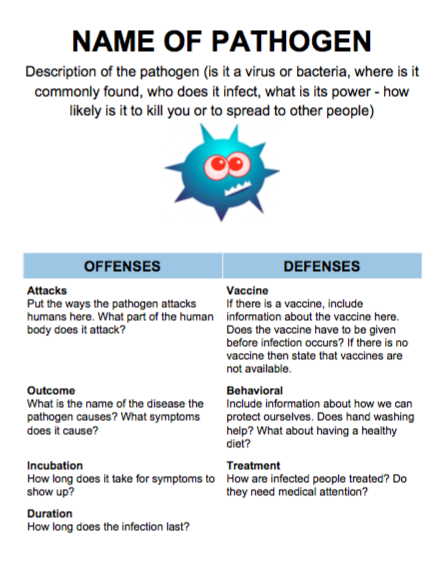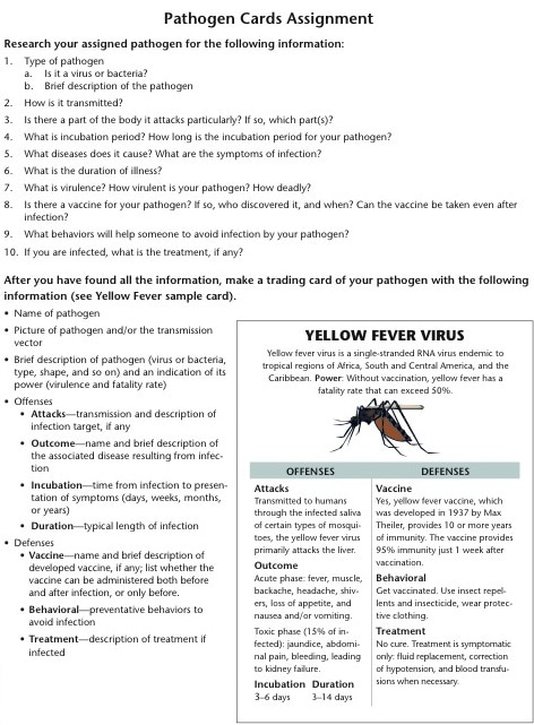Make a playing cardThe first part of this assignment is to make a playing card for a disease. You will work in pairs. In order to make the playing card you need to save a copy of the template to your iPad for you to edit.
To complete the playing card you need to replace the text on the template. Please keep the font type, color, and size the same so that all our playing cards look like they go together.
In the table at the bottom of the card you need to keep the bold label text but then type the information below the label. |
How to play the game:
The game is played in pairs.
(If you must have a group of three then each player gets 3 characters)
Each player starts with 5 characters. The goal of the game is to keep all 5 characters healthy. The game ends when either player’s characters are all “sick” or after a time set by the teacher. The winner is the player with the greatest number of healthy characters remaining.
After you are familiar with the game, develop one rule modification that will represent another important variable in either bacterial or viral disease transmission. Some possible suggestions include the following:
Each player starts with 5 characters. The goal of the game is to keep all 5 characters healthy. The game ends when either player’s characters are all “sick” or after a time set by the teacher. The winner is the player with the greatest number of healthy characters remaining.
- Shuffle the deck and pass out 5 cards to each player. Place the remaining cards in a pile face down between the two players.
- To start have one person play a card out of their hand to attack their opponent or defend there characters. Take turns playing cards to attack or defend. You can also discard unwanted cards. Each player may play as many cards out of their hand as they like, however, they may only draw 5 cards at the end of each turn. If one person is done playing their cards but the other player wants to play more cards they can.
- Cards that may be played during a turn:
- Attacks—pathogen cards are attacks played against the opposing player’s characters. When the opposing player’s character has been attacked, place the pathogen card below the character card.
- Characters can only have one pathogen at a time.
- Bacteria can be played against any character.
- Viruses without vaccines can be played against any character.
- Viruses with vaccines cannot be played against a character with a vaccination card.
- There are select viruses (e.g., Rabies, Variella-Zoster) that can be treated with vaccine post-infection (if this is the case, it should say so on the pathogen card). If the opposing player has a vaccination card in his or her hand when attacked by one of these viruses, he or she can play the vaccination card at that time, and both the virus and vaccination cards are placed immediately into the discard pile.
- Attacks—pathogen cards are attacks played against the opposing player’s characters. When the opposing player’s character has been attacked, place the pathogen card below the character card.
- Defenses—there are two types of defenses that can be played on your turn:
- Preemptive vaccines—vaccinations can be placed preemptively on a character to protect them from future virus attacks. A vaccination card will protect that character from any virus attack that has a vaccine. However, not all viruses have vaccines.
- Antibiotics—antibiotics are played on characters that have previously been attacked with a bacterial infection. Each bacterial infection needs to be treated with antibiotics for three consecutive turns before the character is healed.
- Discard—you may discard any unwanted cards from your hand into the discard pile.
- After each person has played all cards of their choice, the turn is over. Update the health status of all of your characters.
- Viral infections—flip over any characters that have a virus at the end of the turn. This character is now “sick” and out of the game. Return the virus card and any defense cards to the discard pile.
- Bacterial infections
- No antibiotic played—if a character has a bacterial infection and no antibiotics card was played this turn, flip the card over and return any defense cards to the discard pile.
- First or second antibiotic played—if a character has a bacterial infection and the first or second antibiotics card was played this turn, nothing happens.
- Third antibiotic played—if a character has a bacterial infection and a third antibiotics card was played this turn, discard the pathogen card and all antibiotics cards to the discard pile (vaccination card remains, if any). The character is now healthy.
- When the turn is over, both players draw up to 5 cards, as necessary.
- The next player may now play cards.
After you are familiar with the game, develop one rule modification that will represent another important variable in either bacterial or viral disease transmission. Some possible suggestions include the following:
- Have separate vaccination cards for each virus.
- Include incubation time listed on the cards as part of the game. Have each incubation time correspond to a set number of turns. Antibiotics are not used until the incubation time has elapsed.
- Include fatality rate and/or disease duration as part of the game. Have diseases last a set number of turns, and when this time is over, roll a die to see if the disease was fatal (based on fatality rate from pathogen card). Only fatalities are flipped; otherwise, characters recover. Have students play the pathogen game again after making their rule revisions. You may need to used some extra simple props (e.g., pennies) or alter the cards in some way to play the revised game.
Proudly powered by Weebly

